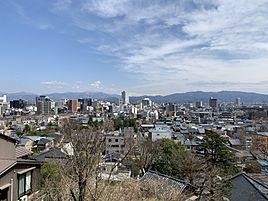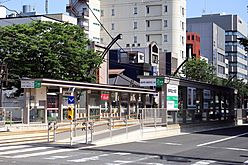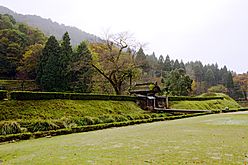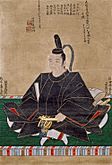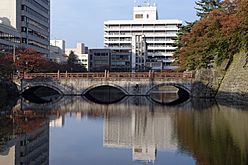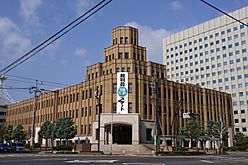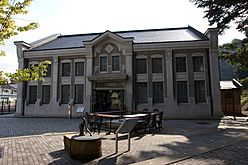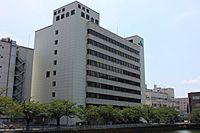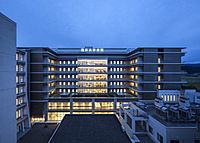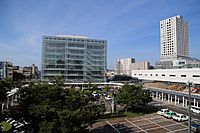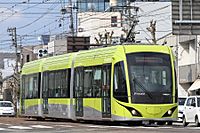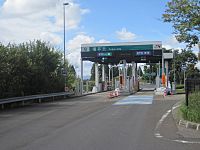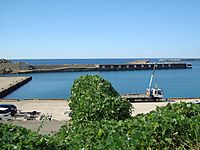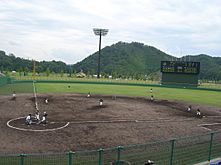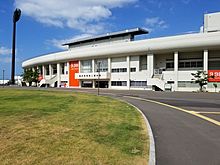Fukui (city) facts for kids
Quick facts for kids
Fukui
福井市
|
|||||||||||
|---|---|---|---|---|---|---|---|---|---|---|---|
|
|||||||||||
|
|||||||||||

Location of Fukui in Fukui Prefecture
|
|||||||||||
| Country | Japan | ||||||||||
| Region | Chūbu (Hokuriku) | ||||||||||
| Prefecture | Fukui | ||||||||||
| Area | |||||||||||
| • Total | 536.41 km2 (207.11 sq mi) | ||||||||||
| Population
(July 1, 2017)
|
|||||||||||
| • Total | 264,217 | ||||||||||
| • Density | 492.565/km2 (1,275.738/sq mi) | ||||||||||
| Time zone | UTC+9 (Japan Standard Time) | ||||||||||
| Phone number | 0776-20-5111 | ||||||||||
| Address | 3-10-1 Ōte, Fukui-shi, Fukui-ken 910-8511 | ||||||||||
| Climate | Cfa | ||||||||||
|
|||||||||||
Fukui (福井市, Fukui-shi) is the capital city of Fukui Prefecture, Japan. As of March 1, 2024, about 255,332 people live here in 107,553 homes. The city covers an area of 536.41 square kilometers (207.11 sq mi). This means there are about 476 people living in each square kilometer. Most people live in the city center. However, Fukui also includes countryside areas, mountains, and suburbs.
Contents
- Exploring Fukui City
- Fukui's Location and Weather
- Fukui's Population Over Time
- Fukui's Rich History
- Fukui's Global Connections
- Fukui's Economy: How People Make a Living
- Learning in Fukui: Schools and Universities
- Getting Around Fukui: Transportation
- Fun Places to Visit in Fukui
- Fukui's Culture and Sports
- See also
Exploring Fukui City
City Views: What Fukui Looks Like
Fukui is a mix of old and new. You can see modern buildings and busy streets. There are also quiet, green spaces. The city has grown a lot over the years.
-
Downtown of Fukui City (2018)
Fukui's Location and Weather
Where is Fukui Located?
Fukui is in the north-central part of Fukui Prefecture. It sits on a flat area near the coast. To the west, it touches the Sea of Japan. To the east, you'll find the Ryōhaku Mountains. The Kuzuryū River flows right through the city.
Fukui's Climate: Hot Summers and Snowy Winters
Fukui has a humid subtropical climate. This means it has hot and humid summers. Winters are cool and can be very snowy. It rains a lot throughout the year, especially in December and January.
Neighboring Towns and Cities
Fukui shares its borders with several other places in Fukui Prefecture:
Fukui's Population Over Time
How Many People Live in Fukui?
The number of people living in Fukui has stayed about the same for the last 40 years.
| Census data | ||
|---|---|---|
| Year | Pop. | ±% |
| 1873 | 39,784 | — |
| 1970 | 231,901 | +482.9% |
| 1980 | 259,638 | +12.0% |
| 1990 | 270,911 | +4.3% |
| 2000 | 269,557 | −0.5% |
| 2010 | 266,796 | −1.0% |
| 2020 | 262,328 | −1.7% |
| Source: Fukui population statistics, Japanese Imperial Commission [1] (1873) | ||
Fukui's Rich History
Early Days of Fukui
Before Fukui Prefecture was created in 1871, this area was made up of two old provinces: Wakasa and Echizen.
During the Edo period (1603-1868), the powerful family that ruled this region was called Matsudaira. They were related to Tokugawa Ieyasu, a very famous leader in Japanese history.
The Sengoku Period: Battles and Castles
The Sengoku period (1467-1615) was a time of many wars in Japan. In 1471, the Asakura family became the military leaders of Echizen Province. Asakura Toshikage (1428–1481) built strong defenses around a place called Ichijōdani. He built forts on the mountains and walls to protect the valley.
Inside this protected area, he built a large mansion. Around it were homes for his family and loyal followers. Later, shops for merchants and workshops for artists appeared, along with Buddhist temples. Many skilled people from Kyoto came here to escape the wars. Ichijōdani became a very important place for culture, military power, and people. At its busiest, over 10,000 people lived there.
The Asakura family was friendly with the Ashikaga shogunate, which was the military government of Japan at the time. This led them to clash with Oda Nobunaga, another powerful leader. Nobunaga attacked Echizen Province. Because of Asakura Yoshikage's lack of military skill, Nobunaga's forces won important battles in 1570. This left the Asakura lands open to invasion.
In 1573, Nobunaga completely destroyed Ichijōdani Castle.
Kitanosho Castle was built by Shibata Katsuie in 1575. It was known for its huge main tower, which was nine stories tall. This made it the largest castle tower of its time!
Edo Period: A Castle Town Develops
During the Edo period, Fukui became a jōkamachi (a castle town). It was the center of the Fukui Domain, a territory ruled by a powerful lord under the Tokugawa shogunate.
Fukui played a big part in the Meiji restoration, a major change in Japan's government in the late 1800s. The modern city of Fukui was officially created on April 1, 1889.
Modern Challenges and Growth
Before World War II, Fukui grew into an important center for factories and railroads. Companies in the area made things like airplane parts, electrical goods, and textiles.
On June 19, 1945, during World War II, Fukui was heavily damaged by bombing. Most of the city, about 84.8%, was destroyed.
Fukui faced another big challenge in 1948 when a major earthquake hit the city.
In 2006, some nearby towns and villages joined Fukui, making the city bigger. On April 1, 2019, Fukui was named a "core city." This means it has more power to make its own decisions.
Fukui's Global Connections
Sister Cities Around the World
Fukui has "sister city" relationships with cities in other countries. This helps build friendships and understanding between different cultures.
- Sister cities
| City | Country | State | since |
|---|---|---|---|
| May, 1982 | |||
| November, 1989 |
- Friendship cities
| City | Country | State | since |
|---|---|---|---|
| November, 1989 | |||
| April, 2001 |
Friendships Within Japan
Fukui also has special relationships with other cities in Japan.
- Sister cities
| City | Prefecture | region | since |
|---|---|---|---|
| Kyūshū region | November, 1994 |
- Friendship cities
| City | Prefecture | region | since |
|---|---|---|---|
| Kantō region | April, 2002 |
- Partnership cities
| City | Prefecture | region | since |
|---|---|---|---|
| Chūbu region | August 9, 2013 |
Fukui's Economy: How People Make a Living
Fukui has a varied economy. It's a center for business and money in the region. But manufacturing, farming, and fishing are also very important.
Farming and Fishing in Fukui
Agriculture: Growing Food
- Japan Agricultural Cooperatives (JA)
- Fukui Prefecture Agricultural Cooperatives (JA FukuiPrefecture)
Fishing Industry: From the Sea
- Japan Fisheries cooperative (JF)
- FukuiCity Fisheries cooperative (JF FukuiCity)
Factories and Companies in Fukui
Manufacturing: Making Things
Several companies have their main offices or factories in Fukui:
- Kumagai Gumi: A big construction company.
- Matsuura Machinery: Makes heavy machines for international use.
- Morinaga Hokuriku Dairy: A company that makes dairy products.
Services: Helping People and Businesses
Service Industry: Providing Help
- Emori Shoji: A trading company that works closely with China.
- Keifuku Bus: A local bus company.
Learning in Fukui: Schools and Universities
Fukui has many places for students to learn, from high schools to universities.
Universities and Colleges
- Fukui College of Health Sciences
- Fukui Prefectural University
- Fukui University of Technology
- Jin-ai Women's College
- University of Fukui
High Schools in Fukui
- Asuwa Senior High School
- Fujishima Senior High School
- Fukui Commercial Senior High School
- Fukui Minami Senior High School
- Fukui Norin Senior High School
- Fukui University of Technology - Fukui Senior High School
- Hokuriku Senior High School
- Jin-ai Girl's Senior High School
- Kagaku-Gijutsu Senior High School
- Keishin Senior High School
- Koshi Senior High School
- Michimori Senior High School
- Usui Senior High School
Other Schools
- Fukui Prefectural School for the Blind
- Fukui Prefectural School for the Deaf
- Hokuriku Korean Elementary and Junior High School
Getting Around Fukui: Transportation
Fukui has many ways to travel, including trains, roads, and even a port.
Train Travel in Fukui
High-Speed Rail: Shinkansen
- Hokuriku Shinkansen: High-speed train service started on March 16, 2024.
Local Train Lines
- Etsumi-Hoku Line (Kuzuryū Line)
- Fukubu Line
- Mikuni Awara Line
- Katsuyama Eiheiji Line
- Hapi Line Fukui
Roads and Highways
Expressways
National Routes
 National Route 8
National Route 8 National Route 158
National Route 158 National Route 305
National Route 305 National Route 364
National Route 364 National Route 416
National Route 416
Sea Travel
Sea Port
- Port of Takasu
Fun Places to Visit in Fukui
Fukui has many interesting places to explore, from historical sites to beautiful gardens.
- Asuwa River: A lovely river, especially known for its cherry blossoms.
- Fukui International Activities Plaza: A place for international exchange.
- Harmony Hall Fukui: A concert hall for music and performances.
- Ichijōdani Asakura Family Historic Ruins: Very important historical ruins from the Sengoku period.
- Fukui Castle: The remains of an old castle.
- Fukui Fine Arts Museum: A museum showcasing art.
- Kitanosho Castle: Another historic castle site.
- Peace Pagoda: A special tower built for peace, opened in 1959.
- Yōkōkan Garden: A beautiful traditional Japanese garden.
- "Yoroppaken": Famous for Fukui's special dish, sauce katsudon (pork cutlet with sauce on rice).
Fukui's Culture and Sports
Sports Teams in Fukui
Fukui is home to several sports teams:
Baseball
- Fukui Wild Raptors (part of the BC.League)
Handball
- Hokuriku Electric Power Company Blue Thunder (plays in the JHL)
Soccer
- Fukui United FC (plays in the Hokushinetsu Football League)
See also
 In Spanish: Fukui (Fukui) para niños
In Spanish: Fukui (Fukui) para niños


